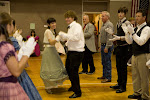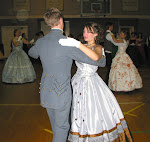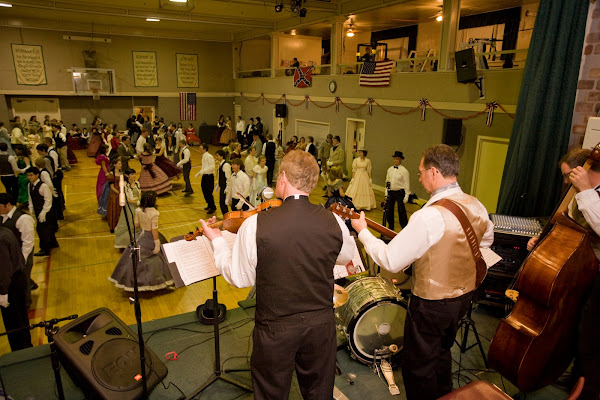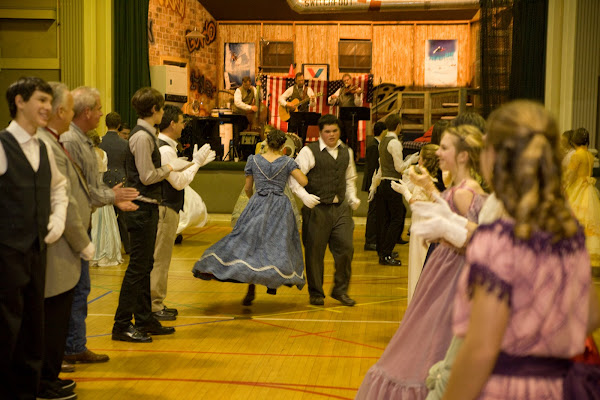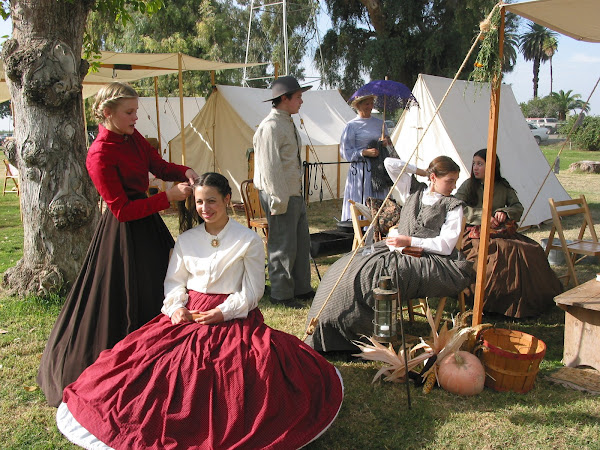Like most little girls, whenever I had a pretty dress and music was playing, I would twirl around and around to the music. But the first time that I was ever in a “structured” dance with a partner was in fifth grade. I grew up in Los Angeles where at Hickory Elementary School you were introduced to different sports every semester. One year we learned to play baseball, and another year it was volley ball. However, when you were in fifth grade, the spring semester was for learning how to square dance.
Miss Brown was my fifth grade teacher, and she was a formidably large woman in her fifties who had given her life to teaching. She was strict and stern, and we were all a little afraid of her. So when she told the boys to stand next to a girl and swing her around by the elbow, they muffled their “ewws” and “yucks” and did just what she said. When she told the girls to hold those boy’s sweaty hands and promenade around the circle, we did. Sweaty hands aside, I thought square dancing was amazing. To be able to work with other kids and create patterns and move to the music was wonderful.
An interesting side note about Miss Brown. In fifth grade, we studied the westward expansion. While the other fifth grade classes were drawing pictures of forts, Miss Brown brought in a bunch of refrigerator boxes, and we cut them up and painted them and turned our classroom into a western town complete with mercantile shops with cardboard awnings. She would read to us stories about the “wild west,” and we would write letters to the other students in the class and take them to our western “town post office” to mail them. To this day, I love creating “historical sets” and living out history.
A few weeks ago our family lived in a canvas tent at the Fresno Civil War Reenactment where there was book reading, letter writing, music and dancing. I think Miss Brown would be pleased.
Talent is Overrated - Take 2
Did you practice your dancing this week? Because you may find that that deliberate practice and support from a mentor has a lot more to do with your dancing ability than you may think.
From an early age, Wolfgang Mozart received musical instruction from an expert teacher, Leopold Mozart, his father. Leopold was a famous performer and composer in his own right who was also very interested in how music was taught to children. He wrote a book about violin instruction that was influential for decades. He began to teach Wolfgang to play and compose when the little boy was around three years old.
Wolfgang Mozart’s first four piano concertos, composed when he was eleven years old, contained no original music. Mozart put them together out of other composer’s music as most beginning composers do. Mozart’s first masterpiece – Piano Concert No. 9 was composed when he was twenty-one years old. That is an early age to compose such a masterpiece, but by this point Wolfgang had been through eighteen years of extremely diligent training.
And Tiger Woods? From an early age, Tiger Woods received golf instruction from an expert golfer and passionate teacher – his father. Tiger received a golf club at seven months of age. Tiger’s high chair was set up in the garage where Tiger watched his father hit balls into a net for hours on end. Before Tiger was two, he and his father were on the golf course practicing regularly. Tiger Woods has repeatedly credited his father for his success and has written, “Golf for me was an apparent attempt to emulate the person I looked up to more than anyone: my father.” When asked to explain Tiger’s success, both father and son give the same reason: Hard work.
Shizuka Arakawa knows what it means to work hard. Arakawa began training as a skater when she was five years old, and when she was twenty-four years old, she won the gold medal in figure skating at the 2006 Winter Olympics. Winning means performing flawlessly moves that most of us would consider impossible. Practicing jumps that win Olympic gold means falling down – in a thin costume on cold, hard ice – a lot. It is estimated that Arakawa fell down at least twenty thousand times before achieving Gold.
Does this mean that people must have a motivated parent or teacher training them by three or five years old if they are to be good at anything? No! There seems to be a ten year rule that researchers have discovered when they study outstanding performers in all domains. It takes most writers, musicians, dancers and businessmen ten years of diligent study and work before they begin to accomplish what society considers great. Howard Gardner, author of Creating Minds said, “I’ve been struck throughout this study by the operation of the ten-year rule… Should one begin at age four, like Picasso, one can be a master by the teenage years; composers like Stravinsky and dancers like Graham, who did not begin their creative endeavors until later adolescence, did not hit their stride until their late twenties.”
Geoff Colvin ends his book Talent is Overrated by saying, “The evidence offers no easy assurances. It shows that the price of top-level achievement is extraordinarily high. Perhaps it’s inevitable that not many people will choose to pay it. But the evidence shows also that by understanding how a few become great, anyone can become better. Above all, what the evidence shouts most loudly is striking, liberating news: that great performance is not reserved for a preordained few. It is available to you and everyone.” So keep dancing!
From an early age, Wolfgang Mozart received musical instruction from an expert teacher, Leopold Mozart, his father. Leopold was a famous performer and composer in his own right who was also very interested in how music was taught to children. He wrote a book about violin instruction that was influential for decades. He began to teach Wolfgang to play and compose when the little boy was around three years old.
Wolfgang Mozart’s first four piano concertos, composed when he was eleven years old, contained no original music. Mozart put them together out of other composer’s music as most beginning composers do. Mozart’s first masterpiece – Piano Concert No. 9 was composed when he was twenty-one years old. That is an early age to compose such a masterpiece, but by this point Wolfgang had been through eighteen years of extremely diligent training.
And Tiger Woods? From an early age, Tiger Woods received golf instruction from an expert golfer and passionate teacher – his father. Tiger received a golf club at seven months of age. Tiger’s high chair was set up in the garage where Tiger watched his father hit balls into a net for hours on end. Before Tiger was two, he and his father were on the golf course practicing regularly. Tiger Woods has repeatedly credited his father for his success and has written, “Golf for me was an apparent attempt to emulate the person I looked up to more than anyone: my father.” When asked to explain Tiger’s success, both father and son give the same reason: Hard work.
Shizuka Arakawa knows what it means to work hard. Arakawa began training as a skater when she was five years old, and when she was twenty-four years old, she won the gold medal in figure skating at the 2006 Winter Olympics. Winning means performing flawlessly moves that most of us would consider impossible. Practicing jumps that win Olympic gold means falling down – in a thin costume on cold, hard ice – a lot. It is estimated that Arakawa fell down at least twenty thousand times before achieving Gold.
Does this mean that people must have a motivated parent or teacher training them by three or five years old if they are to be good at anything? No! There seems to be a ten year rule that researchers have discovered when they study outstanding performers in all domains. It takes most writers, musicians, dancers and businessmen ten years of diligent study and work before they begin to accomplish what society considers great. Howard Gardner, author of Creating Minds said, “I’ve been struck throughout this study by the operation of the ten-year rule… Should one begin at age four, like Picasso, one can be a master by the teenage years; composers like Stravinsky and dancers like Graham, who did not begin their creative endeavors until later adolescence, did not hit their stride until their late twenties.”
Geoff Colvin ends his book Talent is Overrated by saying, “The evidence offers no easy assurances. It shows that the price of top-level achievement is extraordinarily high. Perhaps it’s inevitable that not many people will choose to pay it. But the evidence shows also that by understanding how a few become great, anyone can become better. Above all, what the evidence shouts most loudly is striking, liberating news: that great performance is not reserved for a preordained few. It is available to you and everyone.” So keep dancing!
Talent is Overrated
“I can’t dance. I have no talent for it.”
“Sure you can! Talent is overrated!”
I am currently reading a book by Geoff Colvin entitled Talent is Overrated. His premise is that no one is a natural born musician, doctor, businessman… or dancer. He gives some compelling examples of people who look like they have amazing natural talent, but their great ability actually comes from hours and hours of deliberate practice. Colvin says, “Deliberate practice is hard. It hurts. But it works. More of it equals better performance. Tons of it equals great performance.”
Deliberate practice is more than just working hard. It’s asking questions such as, “What exactly needs to be practiced. Precisely how? Which specific skills or assets must be acquired?”
Dr. Suzuki asked these questions of what it took to play violin. He was able to take various songs and break them down into their essential parts and then link the study of these parts sequentially creating a methodical way of learning to play the violin. He coupled the method with the supportive and motivating team of parent and teacher, told students that they only had to practice on days that they ate, and encouraged each student with the statement that “Every Child Can.” (A variation on “talent is overrated.) The result has been that many young children have been able to learn classical pieces that were thought to be impossible for that age level several decades earlier. Our family has had personal experience with the Suzuki Program as both of our daughters have graduated from all 10 books of the Suzuki violin program, and our eldest daughter is now a Suzuki violin teacher who shares the vision that “Every Child Can” with her own students.
In 1992, a group of researchers went looking for musical talent. They couldn’t find it. They looked at 257 young people in England where there is a rigorous and uniform grading system for young musicians that places them in one of nine grades. In comparing the highest level students with some of the lower level students, they found that there was no evidence for early or natural talent.
Colvin said, “The researchers calculated the average hours of practice needed by the most elite group of students to reach each grade level, and they calculated the average hours needed by each of the other groups. There were no statistically significant differences. For students who ended up going to the elite music school as well as for students who just played casually for fun, it took an average of twelve hundred hours of practice to reach grade 5, for example. The music school students reached grade levels at earlier ages that the other students for the simple reason that they practiced more.
By age twelve, the researchers found, the students in the most elite group were practicing an average of two hours a day versus about fifteen minutes a day for the students in the lowest group, an 800 percent difference. So students could put in their hours a little bit each day or a lot each day, but nothing, it turned out, enabled an group to reach any given grade level without putting in those hours. As one of the researchers… put it, ‘There is absolutely no evidence of a ‘fast tract’ for high achievers.’”
But wait! Surely Mozart was naturally talented? Look for Mozart’s – and Tiger Wood’s – stories in next week’s blog.
Until then – we’ll just keep practicing our dancing!
“Sure you can! Talent is overrated!”
I am currently reading a book by Geoff Colvin entitled Talent is Overrated. His premise is that no one is a natural born musician, doctor, businessman… or dancer. He gives some compelling examples of people who look like they have amazing natural talent, but their great ability actually comes from hours and hours of deliberate practice. Colvin says, “Deliberate practice is hard. It hurts. But it works. More of it equals better performance. Tons of it equals great performance.”
Deliberate practice is more than just working hard. It’s asking questions such as, “What exactly needs to be practiced. Precisely how? Which specific skills or assets must be acquired?”
Dr. Suzuki asked these questions of what it took to play violin. He was able to take various songs and break them down into their essential parts and then link the study of these parts sequentially creating a methodical way of learning to play the violin. He coupled the method with the supportive and motivating team of parent and teacher, told students that they only had to practice on days that they ate, and encouraged each student with the statement that “Every Child Can.” (A variation on “talent is overrated.) The result has been that many young children have been able to learn classical pieces that were thought to be impossible for that age level several decades earlier. Our family has had personal experience with the Suzuki Program as both of our daughters have graduated from all 10 books of the Suzuki violin program, and our eldest daughter is now a Suzuki violin teacher who shares the vision that “Every Child Can” with her own students.
In 1992, a group of researchers went looking for musical talent. They couldn’t find it. They looked at 257 young people in England where there is a rigorous and uniform grading system for young musicians that places them in one of nine grades. In comparing the highest level students with some of the lower level students, they found that there was no evidence for early or natural talent.
Colvin said, “The researchers calculated the average hours of practice needed by the most elite group of students to reach each grade level, and they calculated the average hours needed by each of the other groups. There were no statistically significant differences. For students who ended up going to the elite music school as well as for students who just played casually for fun, it took an average of twelve hundred hours of practice to reach grade 5, for example. The music school students reached grade levels at earlier ages that the other students for the simple reason that they practiced more.
By age twelve, the researchers found, the students in the most elite group were practicing an average of two hours a day versus about fifteen minutes a day for the students in the lowest group, an 800 percent difference. So students could put in their hours a little bit each day or a lot each day, but nothing, it turned out, enabled an group to reach any given grade level without putting in those hours. As one of the researchers… put it, ‘There is absolutely no evidence of a ‘fast tract’ for high achievers.’”
But wait! Surely Mozart was naturally talented? Look for Mozart’s – and Tiger Wood’s – stories in next week’s blog.
Until then – we’ll just keep practicing our dancing!
Dresses
I’ve made a lot of dresses over the years. My first dress was a lime green jumper that I made in my Jr. High Home Economics class. I took sewing in high school too, and there I made a much fancier blue sundress with ties at the shoulders. I went on to make small dresses for my daughters when they were young, and then even smaller dresses for their dolls as they got older. My most recent sewing accomplishment is a blue and white checked Civil War era day dress, complete with pagoda sleeves and gold trim. I wore it last weekend at the Fresno Civil War Reenactment where we lived as if in another century for three days.
Of course all of the ladies who reenact wear dresses, but most of the public observers who attend do not. But I hope that the girls that we spoke with got glimpse of what they were missing. When a lady wears a lovely dress, I think she finds herself more inclined to sit straighter, walk more gracefully and feel over all more elegant and refined.
The first day of the reenactment was a field trip day for local school children. As we walked between the different education stations, the youngest girls would look and point and exclaim to their friends, “It looks like they’re floating!” when hoop-skirted ladies would glide by. A group of teenage girls dressed all alike in camouflage army fatigues came up to me and my friend as we walked down the main street. They all wanted to know where we got our dresses, and each one wanted to be in a photo with us. My friend remarked after the girls had walked on, “Deep down, they would rather be wearing dresses.”
While a group of us were sitting in camp, three teenage girls came up to ask us questions. They also wanted to know where we got our dresses. When I told the girls that I made my dress, one of them looked surprised and said, “I don’t even own a dress.” My dear friend, who has been reenacting for years sharing her vision of southern gentil womanhood with many girls, said, “But wouldn’t you like to?”
Will the girls we met this weekend remember the ladies in the fancy dresses? Did we inspire them, even a little bit, to be graceful, beautiful and feminine? I hope we did.
Of course all of the ladies who reenact wear dresses, but most of the public observers who attend do not. But I hope that the girls that we spoke with got glimpse of what they were missing. When a lady wears a lovely dress, I think she finds herself more inclined to sit straighter, walk more gracefully and feel over all more elegant and refined.
The first day of the reenactment was a field trip day for local school children. As we walked between the different education stations, the youngest girls would look and point and exclaim to their friends, “It looks like they’re floating!” when hoop-skirted ladies would glide by. A group of teenage girls dressed all alike in camouflage army fatigues came up to me and my friend as we walked down the main street. They all wanted to know where we got our dresses, and each one wanted to be in a photo with us. My friend remarked after the girls had walked on, “Deep down, they would rather be wearing dresses.”
While a group of us were sitting in camp, three teenage girls came up to ask us questions. They also wanted to know where we got our dresses. When I told the girls that I made my dress, one of them looked surprised and said, “I don’t even own a dress.” My dear friend, who has been reenacting for years sharing her vision of southern gentil womanhood with many girls, said, “But wouldn’t you like to?”
Will the girls we met this weekend remember the ladies in the fancy dresses? Did we inspire them, even a little bit, to be graceful, beautiful and feminine? I hope we did.
Subscribe to:
Comments (Atom)


